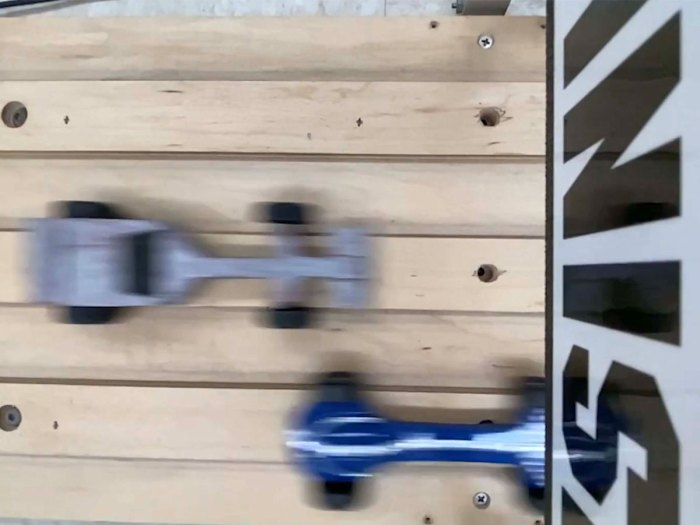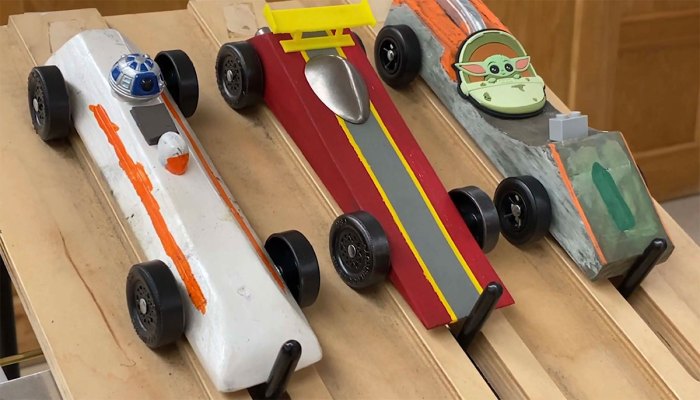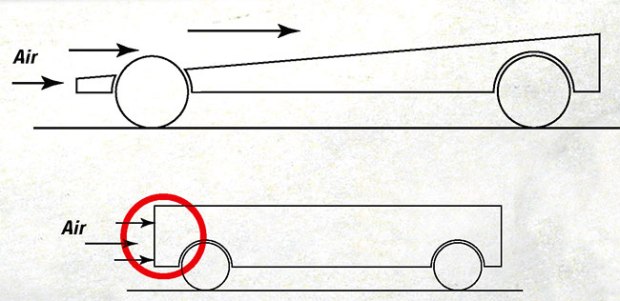How to Make a Fast Pinewood Derby Car

Packs nationwide are gearing up for their annual Pinewood Derby race, and the one thing everyone wants to know: How do I make a fast Pinewood Derby car?
There are a variety of ways to make your Pinewood Derby car go faster. Explore the following tips to optimize your car’s performance and gain a competitive edge in an upcoming race.
BASIC BUILDING GUIDELINES TO GET YOU STARTED
The possibilities are endless when it comes to creating a fast Pinewood Derby car. Before you begin, consider the following general guidelines:
Avoid Pointed Noses: A pointed nose will make it difficult for your car to rest on the pin at the starting gate. It may also cause your Pinewood Derby car to get bumped around when the pin drops, and it can create problems for electronic timing systems at the finish line.
Weight Distribution: Leave ample wood in the rear of the Pinewood Derby car so you can place additional weight there. Concentrate the majority of the weight in the rear for optimal performance.
Maximum Weight: Aim for the maximum allowable weight allowed by your pack’s rules, typically limited to 5 ounces in most races. If your car falls short of this weight, strategically add coins or other weights to meet the requirement.
Clarity in Orientation: Clearly distinguish the front and back of your Pinewood Derby car. In many races, the race officials — not you — will actually place each car on the track. Sometimes the officials put cars on the track backward because they can’t tell which end is which.
Aerodynamic Design: Select a design that facilitates smooth airflow over and around the car body. Pinewood Derby cars with aerodynamic profiles go faster.
Need design ideas? See photo galleries of hundreds of Pinewood Derby cars.

10 STEPS FOR DESIGNING AND BUILDING A FAST PINEWOOD DERBY CAR
You don’t have to strive for the fastest Pinewood Derby car to have fun competing in your Pinewood Derby. But if you and a helpful adult are willing to put in the extra time and effort, these speed tips are for you.
1. Bake the Block: Start your Pinewood Derby car project by baking the wood block at 250 degrees for two hours. This removes moisture and lightens the block, allowing you to place more weight at the rear of the car where you actually want it.

2. Crafting the Design: Outline your Pinewood Derby car on paper, cut it out, and affix it to the wood block.
Remember, a rectangular car is not an aerodynamic design. The most basic aerodynamic design is a simple wedge. If you don’t have time to design a complex car, a wedge will work just fine.
Download a Pinewood Derby car template PDF to help you create your design.
3. Rough Cut the Design: Use a coping saw or enlist the help of a responsible adult with a power tool to cut out the rough shape of your Pinewood Derby car.
4. Shape Your Car: Smooth edges and shape your car using sandpaper. An adult can assist with a rotary tool or other shaping tools.
5. Sand and Paint Creatively: Reduce friction by smoothing the car’s surface and paint an awesome design to make it look great.
How to paint your Pinewood Derby car to give it a shiny finish.
6. Axles and Wheels Alignment: Make sure they are aligned perfectly straight. You can test the alignment of your axles by pushing your car across a smooth floor or table. It should roll smoothly in a straight line.
- Consider a Three-Wheeler: Raise one wheel about 1/16 inch higher so it never actually touches the track. Less friction = more speed. Rules vary from pack to pack, so make sure to check your pack’s Pinewood Derby rules to make sure three wheelers are allowed in your race.
- Extend the Wheelbase: Maximize the distance between front and rear wheels. Again, make sure this is allowed in your race.
Inspect axles closely to make sure they are smooth without ridges or burrs. You can use sandpaper to remove any imperfections.
Learn about polishing Pinewood Derby axles and wheels to reduce friction.
7. Secure Axles with Glue: Glue the axles firmly in their holes to ensure that they stay perfectly placed, but make sure you don’t get glue on your wheels.
8. Strategic Weight Addition: Remember to make your Pinewood Derby car as heavy as the rules allow. In general, it’s best to place weight to the rear of your car because a heavier rear increases speed.
Learn scientific Pinewood Derby speed tips from a former NASA engineer.
9. Use Graphite: Add graphite or another dry lubricant to reduce friction. The less friction between the body and wheel, the better.
10. Have fun! And finally, remember the most important rule of a Pinewood Derby is that it’s supposed to be fun. While you should always strive to do your best, don’t get caught up in winning or having the fastest car. Just enjoy the ride.
Adapted from the book “Pinewood Derby Speed Secrets,” DK Publishing, $12.95 softcover.
If you drill holes in the bottom to reduce weight, will it slow the car down if they are not filled?
drilling holes will not slow the car down. but if u do want to fill in hole or fix a spot without adding weight I have found that dry wall plaster works great. easy to use sandable and comes in small tubes in hardware dept $2.50? And u can use it to cover up small dents scratches and nail holes in your wall befor u paint. so with kids being kids it wont go to waste.
My boys need to remove more weight, the tip book mentions drilling holes underneath near the front, but does not mention filling them with anything. Will the car go slower if there are holes in the bottom? We need to remove front weight to add it to the back.
Lots of great ideas out there. If your going to make modifications to the car make sure your son is the one doing it. My 7 and 10 year old both did all the work on there cars to include removing bers and polishing the axels. Its not dificult. They learned alot and had fun doing it. Show them how on one and let them do the others. They enjoyed there first place den wins and 2nd and 3rd wins in the overals.
Eh, aerodynamics don’t matter. Graphite and the axles are what matter.
i agree only the axles and wheels matter
a dad in my pack made a smoken fast block
I agree. But if the race comes down to 1-1000 of a second it might help?
I recommend to cut a notch under the front of the car
i would recomend to cut a a slot under the car in front so when the pin go down the car has been movin the whole time
Some people are whiners.our rules are what comes in the box.do check to make sure your pack has no additional rules.then do any tricks you can to make your car faster.there is nothing wrong with a winning legal car.do remember parents its about children. After setting your axles (nails) careful turn car upside down put a little glue on the end of the pointed part of the nails. Seen them come off on race day not a good think to happen
how do i make a derby car go faster any ideas thanks!
make the car as heavy as possible
My son and I had great experiences building his cars together; he doing the labor and me in a supervisory role. In addition to the tips already listed, don’t forget that a good, smooth paint job can make a difference too. Light sanding between coats and finishing with a clear coat will help your speed and ensure you car looks good on the shelf in your room for years to come. Have fun!
i got first in the pack thanks to this
just won